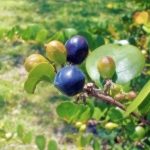Reaching a height of 15 feet and a spread of 15 feet, salt-tolerant Cocoplum grows in full sun or partial shade on a wide range of soils, needing little irrigation once established. Plant 3 to 4 feet apart to establish a hedge farther apart for a less formal effect in a shrub border. Trees are tolerant of urban conditions and have performed well as street trees.
 It should make an effective small tree for urban areas due to its ability to withstand adverse soil types. It should be tried as a street tree for small spaces. The small edible fruit could make a slight mess on walks and patios for a short period. Cocoplum is used most often as a clipped hedge, however, it can be pruned into a multi-trunked small tree or specimen shrub. Emerging foliage is an attractive maroon color.
It should make an effective small tree for urban areas due to its ability to withstand adverse soil types. It should be tried as a street tree for small spaces. The small edible fruit could make a slight mess on walks and patios for a short period. Cocoplum is used most often as a clipped hedge, however, it can be pruned into a multi-trunked small tree or specimen shrub. Emerging foliage is an attractive maroon color.
It can be found in the wild as a small, multi-stemmed tree in the Everglades. Occurs from Cape Canaveral to Key West and Sanibel Florida. There is no current national champion Cocoplum.
Healthy plants respond nicely to reduction pruning which keeps plants small. This pruning technique presents a very formal or neat appearance to the surrounding landscape. Many reduction cuts on branches one-half to three-quarters inch diameter are made at the edge of the canopy every other year. Few if any interior branches are removed. Trees grow slightly larger each year but remain much smaller than they would without pruning. Appropriately performed, few people would recognize that the trees were pruned.
 The fruit is lightly sweet with a flesh consistency that always reminds me of cotton candy. The fruit was used by early inhabitants of peninsular Florida for jams and jellies. To have a pleasant experience eating the fruit, wait until they are fully mature, as immature fruits are astringent. The seeds can be roasted and eaten for their almond-like flavor or crushed. Gopher tortoises and other wildlife love to eat the juicy fruit. In the old days in Jamaica, oil from the seeds was used to make candles, soap, and grease. Black dye was made from the leaves and provided decay-resistant properties to textiles and fishing nets. Seminole Indians also used their twigs to make arrows and the bark as a medicine. Caribbean countries use the bark and leaves as an astringent, to treat dysentery and diarrhea.
The fruit is lightly sweet with a flesh consistency that always reminds me of cotton candy. The fruit was used by early inhabitants of peninsular Florida for jams and jellies. To have a pleasant experience eating the fruit, wait until they are fully mature, as immature fruits are astringent. The seeds can be roasted and eaten for their almond-like flavor or crushed. Gopher tortoises and other wildlife love to eat the juicy fruit. In the old days in Jamaica, oil from the seeds was used to make candles, soap, and grease. Black dye was made from the leaves and provided decay-resistant properties to textiles and fishing nets. Seminole Indians also used their twigs to make arrows and the bark as a medicine. Caribbean countries use the bark and leaves as an astringent, to treat dysentery and diarrhea.
